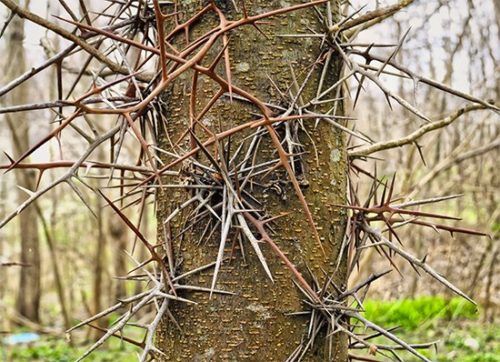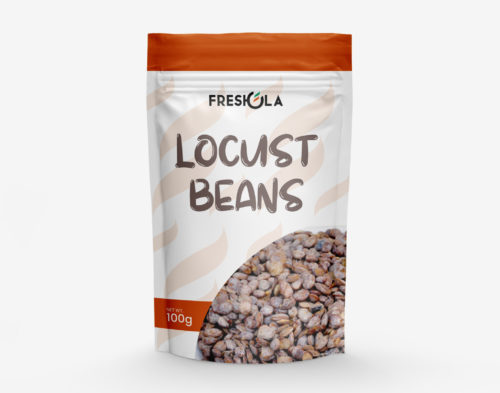When I grew up on the American prairie there were edible plants everywhere.
However, there also was a trend among ranchers and farmers (driven by overly technology-focused agriculture investors — like what Bill Gates is doing today) to see only the worst of native species instead of the best.
Take the honey locust (Gleditsia triacanthos) for just one example.
Here’s how the U.S. government’s National Park service describes them:
Imagine walking through a forested area alongside the Missouri and discovering one of these – a honey locust tree. It’s very possible the men of the Corps did come face-to-face with these nasty thorns, especially in today’s Missouri, Iowa, Nebraska and southeastern South Dakota. But if anyone was injured by them, it didn’t get recorded in the journals.
One of the times honey locusts are mentioned is by John Ordway on July 3, 1804: “The land is Good high bottom pine Timber & black wallnut honey locas oak &C.”
In nature honey locusts grow in both thornless and thorned forms, with spikes growing up to 12″ long. Many regions in the South once referred to the trees as Confederate pin trees because those thorns were used to pin uniforms together during the Civil War. Others claim the thorns have been used throughout history as nails.
And here’s the image the NPS wants you to see.

Nasty thorns. Any guesses why nobody on the expedition recorded being injured by them? My bet is because it didn’t deserve any more mention than any other thorns.
And I have found zero evidence to support any such idea that Confederate soldiers used tree thorns to “pin” their uniforms. Nada. Zilch.
Or let me put it this way: the alleged phrase “pin tree” appears exactly never in an exhaustive search of literature from the 19th Century.
Any guesses why nobody ever recorded the phrase “pin tree”? My bet is because it never happened.
To be fair to the NPS perspective of today, these trees do have a lot of thorns on them. Yet so do roses and raspberries, and how many people go around describing those two beloved plants as nasty?
Instead of focusing just on the thorns of a branch or trunk, let’s talk about delicious edible beans of the locust tree for a minute.
They get the name “honey” from the fact that they in fact have a tasty orange “goo” between seeds in a pod.
And their beans seem to be a high protein source easily grown in the wild (member of the legume family, like lentils and garbanzo).
Ingredients
- 4 Tbsp oil or fat
- 1 Tbsp locust beans
- 1 small chopped onion
- 2 small tomatoes
- Handful of dried and seasoned meat (e.g. fish, fowl)
- Pinch of seasonings (e.g. salt, pepper)
Recipe
- Depod the locust beans (clean, soak/boil for tenderness, wash and remove hull)
- Chop and mix onions and tomatoes
- Put pan on fire and pour in oil or fat to heat for 2 minutes
- Add prepared chopped mix to the oil/fat, stir and cover for 2 minutes
- Add seasonings, prepared locust beans, stir and cover for 5 minutes
- Add prepared meat, stir and cover for 5 minutes
Of course the younger green pods of the tree could be cooked like a green bean. And of course the hard seeds of a mature (dry, brown) pod could be ground into a flour. There are many options, so this is just one to give you an idea of why the NPS focus on the thorns in a story about exploration seems… not very exploratory.
What is truly unfortunate and bizarre is how nobody anywhere seems to have collected traditional recipes from the people who lived on locust bean for generations — Native Americans.
A few years back the President of the National Cattleman’s Beef Association (NCBA) paid me a visit in Silicon Valley.
Very purposefully I took him out for a nice sushi dinner and ordered edamame.
“Soy beans” he exclaimed! “We are supposed to eat livestock feed” he stated flatly albeit genuinely.
“Wait until you see the bill. We’re paying $5 a bowl” I sat back and replied with a wide grin.
Then I helped him off the floor and back into his chair as he said “what in the… we get barely $5 a bushel for our damn soy beans!”
If only he had explored what was all around him the whole time; tried harvesting honey locust beans growing naturally (literally falling from the tree).
Who knows what could have happened if he had ever thought about packaging honey locust beans for human consumption…

My search on locust beans as a Nigerian brought me here. The bean is fermented into a condiment and used as seasoning. It is very popular here. However, I have always wondered if we couldn’t eat them as meals without fermentation. Seeing this post has sparked something in me, and I would most definitely try it. Thank you so much for this.